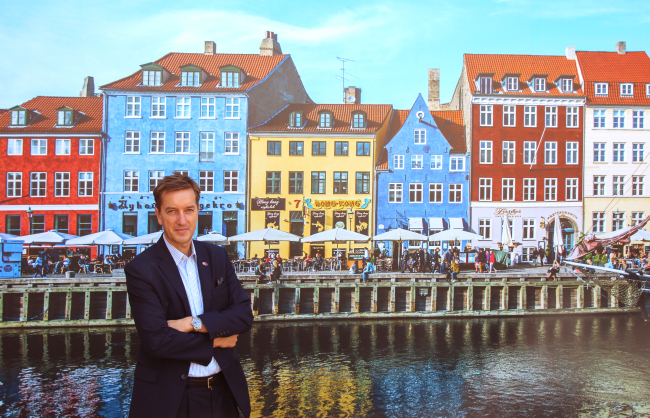With Copenhagen’s hosting of the International Union of Architects (UIA) congress in 2023, Danish cities will encapsulate and further facilitate worldwide efforts for sustainable development at the milepost event, said the country’s top envoy to Korea.
Following a general assembly vote at the UIA World Architects’ Congress in Seoul on Sept. 9, Copenhagen beat out contenders Antalya, Baku, Kuala Lumpur and Lausanne to secure the candidacy of the conference, dubbed, the “Olympics of architecture.”
Organized under the theme of “sustainable futures,” the congress in the Danish capital will explore various ways architects and urban policymakers can contribute to the United Nations’ Sustainable Development Goals, a set of 17 global goals with 169 targets through 2030 aimed at transforming the world’s mode of industrial production and consumption for intergenerational prosperity and security.
The objectives -- ranging from ending poverty and promoting public health and well-being to developing clean energy and fostering industrial innovation -- are integrally tied to the responsible planning, design and administration of cities worldwide, known as sustainable urbanism.
 |
Danish Ambassador to Korea Thomas Lehmann (Danish Embassy) |
In this vein, the global gathering in Copenhagen will be a timely opportunity to discuss the various technological and policy innovations in green growth, said Danish Ambassador Thomas Lehmann in an interview.
“Not only Copenhagen and Denmark, but the whole Nordic region has been strongly committed to sustainable development and sustainable urbanism. We try to live by example of environmentally, socially and economically healthy lives,” he highlighted at the Danish Embassy in Seoul last week.
The Danish presentation at the Seoul congress at Dongdaemun Design Plaza in Seoul from Sept. 2-17 highlighted progress reaped by Danish and Nordic architects in their collective quest to translate sustainability into the built environment, encompassing groundbreaking designs and technologies that save energy while mitigating global warming, according to the envoy.
Copenhagen and Seoul both belong to the C40 Cities Climate Leadership Group, a network of the world’s 40 megacities committed to curbing climate change through sharing of best practices and knowledge.
 |
(From left) Danish Ambassador to Korea Thomas Lehmann; Deputy Convention Director of Wonderful Copenhagen Bettina Reventlow-Mourier; and Seoul Mayor Park Won-soon at the 2017 UIA World Architects' Congress in Seoul at Dongdaemun Design Plaza (Danish Embassy) |
In Denmark, renewable energy accounts for nearly 30 percent of total national energy consumption and over 60 percent of aggregate electricity being generated. Denmark is a world leader in producing wind energy and wind turbine, with half of its electricity coming from wind sources. Biomass is the second-largest green energy source, and investments in solar energy have been gaining ground. The country aims to be carbon-neutral by 2050, while for Copenhagen the target year is 2025.
Pointing to Danish cities’ process of involving citizens in democratic decision-making, Lehmann said, “Some people might say the process is slow and cumbersome, but we have a long planning horizon in our country to encourage civic involvement and engagement. It is a very positive thing because it allows architects and planners to hear citizens’ concerns and needs, and people feel close and committed to the process affecting their lives.”
“It’s about fostering a sense of ownership around the local community,” he explained. “Because the process is based on consensus, people become more satisfied with end results.”
Lehmann pointed to the Copenhagen Harbor -- where citizens can enjoy a variety of cultural and leisurely activities, including swimming, dining and strolling -- as a shining example of attractive and accessible public space.
 |
Danish Ambassador Thomas Lehmann (right) with Danish architects at the 2017 UIA World Architects' Congress in Seoul at Dongdaemun Design Plaza (Danish Embassy) |
Responding to the issue of deepening economic polarization and spatial separation across “creative” postindustrial cities of the globe, as articulated by urban scholar Richard Florida in his new book, “The New Urban Crisis,” the ambassador said Danish cities have also experienced a rise in the value of properties, but that the trend is offset by statutory public housing, which accounts for a quarter of all residential stocks in major cities.
“There is a big renting market in Denmark,” he said. “Everyone, regardless of their income, can live in cities. It makes our cities socially diverse and economically stable.”
Danes are also down-to-earth in terms of their preference for transit, noted Lehmann, heavily relying on bicycles for commute in urban areas. The “unique cycling culture” in Denmark, with bicycles often outnumbering cars, started in the postwar era of economic boom, he said.
“People could have easily chosen automobiles over bicycles during this period, but they made the conscious decision to use bikes as a viable and vital alternative,” according to the diplomat. “And they continue to use bikes, because it’s very efficient, healthy and affordable. There is a well-integrated thinking and infrastructure in terms of incorporating bicycles into urban mobility in Denmark. People can ride on their two wheels, and easily hop onto a subway or train for longer distance travel.”
By Joel Lee (
joel@heraldcorp.com)








![[Herald Interview] 'Trump will use tariffs as first line of defense for American manufacturing'](http://res.heraldm.com/phpwas/restmb_idxmake.php?idx=644&simg=/content/image/2024/11/26/20241126050017_0.jpg)
![[Exclusive] Hyundai Mobis eyes closer ties with BYD](http://res.heraldm.com/phpwas/restmb_idxmake.php?idx=644&simg=/content/image/2024/11/25/20241125050044_0.jpg)
